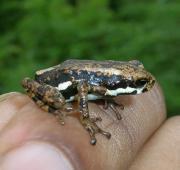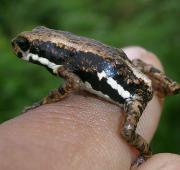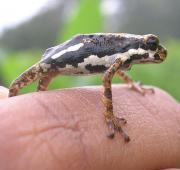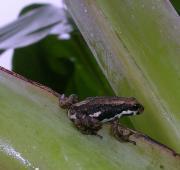 African Tree Toad Classification and Evolution
African Tree Toad Classification and EvolutionThe African Tree Toad is a small species of Toad found in the forests of Central Africa. Today, little is still known about this tiny amphibian and the constantly decreasing population numbers of the African Tree Toad are making it increasingly difficult for us to learn more about them. There are two known subspecies of the African Tree Toad, which are the African Tree Toad and the Bates' Tree Toad. Both African Tree Toad species are of similar size and color but tend to differ in the geographical regions they inhabit.
 African Tree Toad Anatomy and Appearance
African Tree Toad Anatomy and Appearance
The African Tree Toad is generally dark to light brown in colour, with white patches on it's belly and like other Toad species, the African Tree Toad has specially designed feet which aid it's semi-aquatic and tree climbing lifestyle. The African Tree Toad is a terrestrial animal and uses it' s toes to also help it to hop about on the ground. The toes of the African Tree Toad are long and thin, with sticky, round discs on the tips. These widely spread digits enable this Toad to grip onto a larger surface area. The tiny striped body of the African Tree Toad grows up 3.8cm in length making these animals particularly hard to spot amongst the debris on the forest floor.

The African Tree Toad is said to be distributed across it's natural Central African range in countries such as Cameroon, Democratic Republic of the Congo, Equatorial Guinea, Gabon and Nigeria. Despite this though, there are very few records of this elusive amphibian meaning that much of it's distribution (and indeed population size) is simply presumed. The natural habitat of the African Tree Toad is subtropical or tropical moist, lowland forests and heavily degraded former forest, where there is a plentiful water supply. Today however, the African Tree Toad is generally restricted to taller forests.

Like other Toads, the African Tree Toad is a semi-aquatic animal, although it is most commonly found in water when the female is laying her eggs. In a similar way to other tropical Toads, the African Tree Toad spends much of it's life walking, hopping or running about on the ground where it is able to find plenty of food and water. When darkness falls however, the African Tree Toad retreats high into the surrounding vegetation to remain safe during the night from ground-dwelling predators. The color and markings of their skin, gives the African Tree Toad camouflage amongst the surrounding forest, again giving it extra defence from hungry predators.
African Tree Toad Reproduction and Life Cycles
Little is really known about the reproduction of the African Tree Toad besides the fact that female African Tree Toads are known to lay up to 200 sticky eggs in small bodies of water found in hollow tree cavities. These spawning sites are then guarded by the male African Tree Toad until the tiny eggs hatch into tadpoles. It is unknown what the tadpoles feed on, but once developed, they hop out of their watery nest in the tree and begin hunting for food in the forest. African Tree Toads in captivity usually live until they are three or four years old but nothing is known about their lifespan in the wild.
African Tree Toad Diet and Prey
The African Tree Toad is a carnivorous amphibian that shoots it's long, sticky tongue out of it's mouth at incredible speeds to catch and secure it's prey. This also helps the Toad to hold onto it's catch whilst it is trying to eat it. The African Tree Toad primarily hunts small invertebrates including Insects, Worms and Spiders that scuttle amongst the debris on the forest floor. In a similar way to other Toad species, it is thought that the African Tree Toad sits in silence, waiting for lunch to pass by, before catching it with lighting speed.
African Tree Toad Predators and Threats
Due to its small size, the African Tree Toad is believed to have numerous predators within it's warm and wet, woodland environment. Fish, Birds, Lizards, Snakes, rodents and other, larger amphibians like Frogs and Toads are all thought to be common predators of the African Tree Toad. The largest assumed threat to the African Tree Toad is habitat loss in the form of deforestation and, to a lesser extent, both air and water pollution in their natural habitats. Little is known however about the direct affects of habitat loss on the species as a whole.
African Tree Toad Interesting Facts and Features
Very little is known about the African Tree Toad, as only a handful of records exist throughout it's very limited range, and there are in fact no records that confirm it's existence through much of it's so-called natural habitat. It is simply just assumed that the African Tree Toad exists in these areas.
African Tree Toad Relationship with Humans
Although having been studied on a small scale by people, relatively little is still known about this tiny Toad. They have however been known to be involved in the exotic pet trade. The small size of the African Tree Toad makes them very hard to spot in their native habitats meaning that the affect of Human activity on the Toads in these areas is still unknown. Deforestation through much of their natural range, along with growing industry causing rising levels of pollution, are thought to be causing the African Tree Toad population to decline.
African Tree Toad Conservation Status and Life Today
Today, the African tree toad is rarely seen in the African forests but it has been classified as a species that is of Least Concern of becoming extinct in the near future. This is however, based on their presumably wide distribution throughout Central Africa, despite the fact that they are only known to actually exist in a handful of these areas. It is widely assumed that the African Tree Toad populations are in decline.

